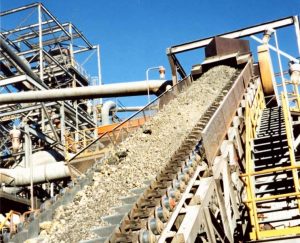What Is the Function of a Conveyor?
 Transporting items from point A to Point B is a common occurrence for almost any type of business and is often accomplished by manpower. However, when the “items” that need to be moved are heavy, dangerous, or difficult to contain and need to be moved continuously in large quantities, a conveyor comes into play. The use of conveyors for material handling has been occurring since as far back as 1795, when basic conveyor systems were used to move grains a short distance. By definition, a conveyor is any piece of mechanical equipment that moves materials from one location to another. In day-to-day business, this could be a belt that is used to sort packages, items coming off a production line, or luggage headed to an airplane cargo hold. For industrial purposes, however, conveyors are much more specialized and must be able to withstand many different types of environments.
Transporting items from point A to Point B is a common occurrence for almost any type of business and is often accomplished by manpower. However, when the “items” that need to be moved are heavy, dangerous, or difficult to contain and need to be moved continuously in large quantities, a conveyor comes into play. The use of conveyors for material handling has been occurring since as far back as 1795, when basic conveyor systems were used to move grains a short distance. By definition, a conveyor is any piece of mechanical equipment that moves materials from one location to another. In day-to-day business, this could be a belt that is used to sort packages, items coming off a production line, or luggage headed to an airplane cargo hold. For industrial purposes, however, conveyors are much more specialized and must be able to withstand many different types of environments.
Conveyors Are Utilized for Many Different Industrial Materials
Heavy-duty conveyors are an integral part of many different industries that rely on the efficient transport of bulk materials. These materials can include sludges, solids, and extremely hazardous compounds that are utilized at some point in a production process. Some of the more common examples include:
- Cement
- Wood chips
- Aggregates
- Industrial waste
- Paper pulp
- Food waste
- Boiler, bottom, and fly ash
- Biomass
- Minerals
- Clinker
Types of Conveyors
The type of conveyor a company utilizes is determined by several factors, including the material that needs to be moved, the distance it needs to go, and the speed by which it must travel. Options include:
Drag Conveyor
A drag conveyor consists of a chain connected to plates that are pulled through a trough.
Bucket Elevator
If you need to elevate the material, a bucket elevator that utilizes gravity or centrifugal force might be a good option.
Screw Conveyor
Screw conveyors are ideal for sludges or fine materials that must be contained in a tube. A rotating screw blade within the tube accomplishes this goal.
Apron Conveyor
Also known as a pan conveyor, this type utilizes overlapping plates that form the carrying surface. It is ideal for abusive environments.
Belt Conveyor
The simplest of conveyor models, a belt conveyor can be used in almost any industry and works with a wide range of materials.
Heavy-Duty Conveyors From Materials Handling Equipment
Since 1927, industrial businesses with material conveyance needs have been relying on Materials Handling Equipment (MHE). We differ from our competitors by offering completely customized conveyors that are engineered for the most severe environments imaginable. We utilize custom-engineered drive components, wear-resistant alloys, and internal Ni-Hard gravity take-up bearings to manufacture conveyors that perform their duties reliably, decade after decade.
If you are interested in learning more about the heavy-duty custom conveyors we offer, contact MHE today to schedule a consultation. We look forward to helping your plant reach new levels of productivity.
